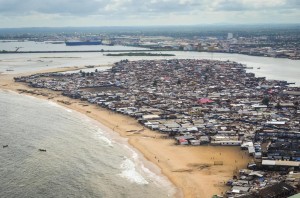This post was written by Dale Kunce, Senior Geospatial Engineer and GIS Team Lead at the American Red Cross. Dale is spearheading the American Red Cross’s involvement in the Missing Maps project.
Unless you’ve been hiding under a rock for the past 11 months, I don’t need to remind you that it’s been a rough year around the globe. I hear news of natural disasters, conflict, and disease outbreaks on the radio every morning… sometimes before I’ve even had my first cup of tea. It can be overwhelming.
But there is good news, too. People halfway around the world can help emergency responders and even prevent disasters from happening in the first place. How?
By making maps.
Updated maps can expedite the delivery of emergency supplies, determine where help is needed most, and even track the spread of diseases like Ebola. But right now, maps of the world’s most vulnerable communities just don’t exist. They’re nowhere to be found. A bunch of people (mappers and non-mappers alike) are getting together to fill in these “missing maps” before the next disaster strikes in these communities. The results can be lifesaving.
Here’s why:
As the world continues to urbanize, one billion people—1/7th of the world’s population—now live in urban slums. Cities often lack sufficient infrastructure to support the impromptu settlements that have sprung up around the world. Overcrowding, poorly built dwellings, and inadequate infrastructure has left hundreds of millions of people in an increased position of vulnerability to disaster and disease. When fires break out or earthquakes hit these areas, it’s really difficult for emergency responders to know who needs help. When Ebola starts spreading, it’s hard to track the virus if epidemiologists can’t conceptualize where towns are located. Sometimes, it’s impossible for help to even make it to the site of a disaster because there are no maps to guide the way.
Here’s how:
The Missing Maps Project brings volunteers together from around the world to fill in the gaps. On Friday, November 7 volunteers will use their own computers to trace existing satellite imagery to create maps of vulnerable communities. With numbers on our side, we can make a huge dent in the missing maps. And when disasters do strike, emergency responders will no longer have to play a guessing game to reach those in need.
We know it will work because we did it for West Africa, when more than 2,000 virtual mappers from over 100 countries made 10 million edits in OpenStreetMap over the last six-months. These contributions allow humanitarian organizations to track the Ebola virus and figure out which areas need the most help. This volume of work would have taken a professional mapper six to eight years to complete.
You can help!
Join a mapathon in your area on November 7 or another date in the nearby future. You can also contribute remotely any day of the week.
Missing Maps is a collaboration the American Red Cross, British Red Cross, Doctors Without Borders-UK, and the Humanitarian OpenStreetMap Team.
